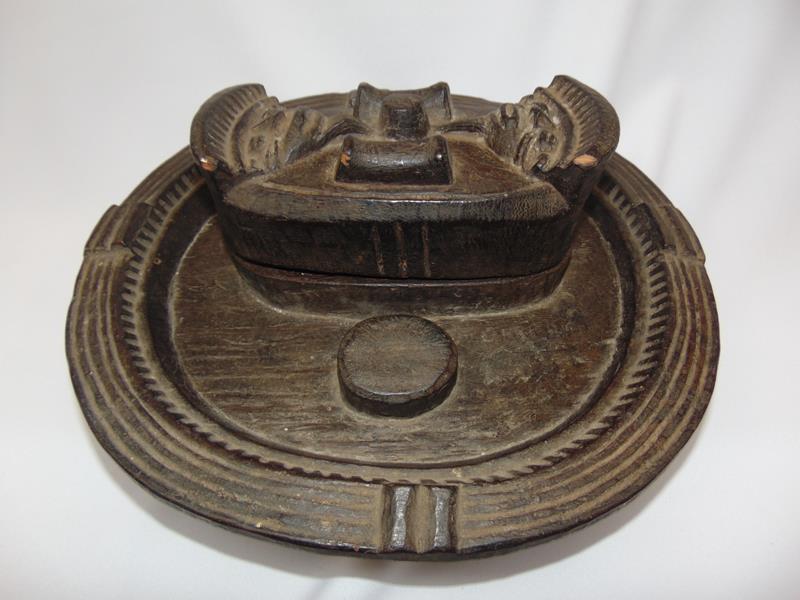A LUBA SONGYE POWER FIGURE sold price request sold
Songye, Dem. Rep. of Congo: a small, male ‘nkisi’ power figure, with a black horn on its head, necklace, and decorative nails. Style: Kalebwe.
A small, stylistically very good and typically crafted ‘nkisi’ power figure’, from the Songye in south-east central Congo. ‘Nkisi’ are power figures and protective sculptures, which are supposed to protect against illness, witchcraft, robbery and general misfortune, as well as ease births. They are also used for divinations and soothsaying. Their own, inner ‘power’ is activated by the ‘nganga’ (priest, soothsayer, healer), in that he ritually places ‘magic material’ (earth, plants and other substances) in hollows on the top of the head, the abdomen or the belt of the ‘nkisi’ and thus ‘consecrates’ it. There are large, over one metre tall ‘nkisi’ sculptures protecting entire village communities, and smaller figures tailored to protect individuals – as is the case with the present one:
this typical, male ‘nkisi’ consists of hard, light-coloured wood and is carved in the ‘classical’ Kalebwe style. Its head is broad and the face, under protruding eyebrow arches, is designed in triangular fashion down to the pointed chin. The slit eyes protrude, the nose is wide, the mouth is open and the chin projects forward. At the top of the head the ‘nkisi’ bears a small, black, antelope horn (from a dik-dik antelope) originally filled with ‘magic material’ hidden in a cavity. His necklace consists of large, old, white and blue glass beads. The arms are bent and hang free by the sides. His proportionally large hands hold the protruding stomach, which contains a cavity for ‘magic material’ at the height of the navel. This cavity is now closed by means of a decorative nail. The figure stands with short legs and large feet on a high, round plinth carved from the same piece. Originally this figure wore, from the knee level down, a sort of skirt (or animal fur). Therefore, the lower part is of unadorned, light-coloured wood. The upper part, down to the knees, was probably from the beginning dyed a darker colour, or it has become darkly patinated through intensive use. Currently, this upper part displays a dark brown to black, partially shiny and encrusted patina, with remains of sacrificial offerings of powdered redwood and palm oil. A crack to the plinth at the front, as well as colour scuffing to the edges, through protracted use. Otherwise no damage.
Description
Height: 38cm height From a private collection number 2136
A ‘Nkisi’ protective power protective figure of the Songye, in southeastern Congo. Among the Songye, typical sculptures such as the present one used to play a major role in the healing the sick, the administration of justice, and in the case of ‘white’ and ‘black’ magic.
Smaller ‘Nkisi’ (such as the present figure) were carved according to more personal, individual patterns, whilst single ‘Nkisi’ of larger size served as protective or guardian figures for the whole village community.
Such ‘Nkisi’ power figures were ‘loaded with magical material’ by a ‘Nganga’ (soothsayer, or priest). These substances could be inserted into a horn atop the head, into a recess in the abdomen or they could be hung as an attribute, providing the ‘Nkisi’ with its ‘magical power’. Carved from dark-coloured hard wood The antelope horn on the head is filled with substances The head is manufactured in typical style with a knop coiffure, large bulging eyes, a flat nose, a wide ‘grinning’ mouth with teeth, and raised scarification marks , sustained with both hands. The skirt made of animal skin .
Smaller ‘Nkisi’ (such as the present figure) were carved according to more personal, individual patterns, whilst single ‘Nkisi’ of larger size served as protective or guardian figures for the whole village community.
Such ‘Nkisi’ power figures were ‘loaded with magical material’ by a ‘Nganga’ (soothsayer, or priest). These substances could be inserted into a horn atop the head, into a recess in the abdomen or they could be hung as an attribute, providing the ‘Nkisi’ with its ‘magical power’. Carved from dark-coloured hard wood The antelope horn on the head is filled with substances The head is manufactured in typical style with a knop coiffure, large bulging eyes, a flat nose, a wide ‘grinning’ mouth with teeth, and raised scarification marks , sustained with both hands. The skirt made of animal skin .

















Reviews
There are no reviews yet.